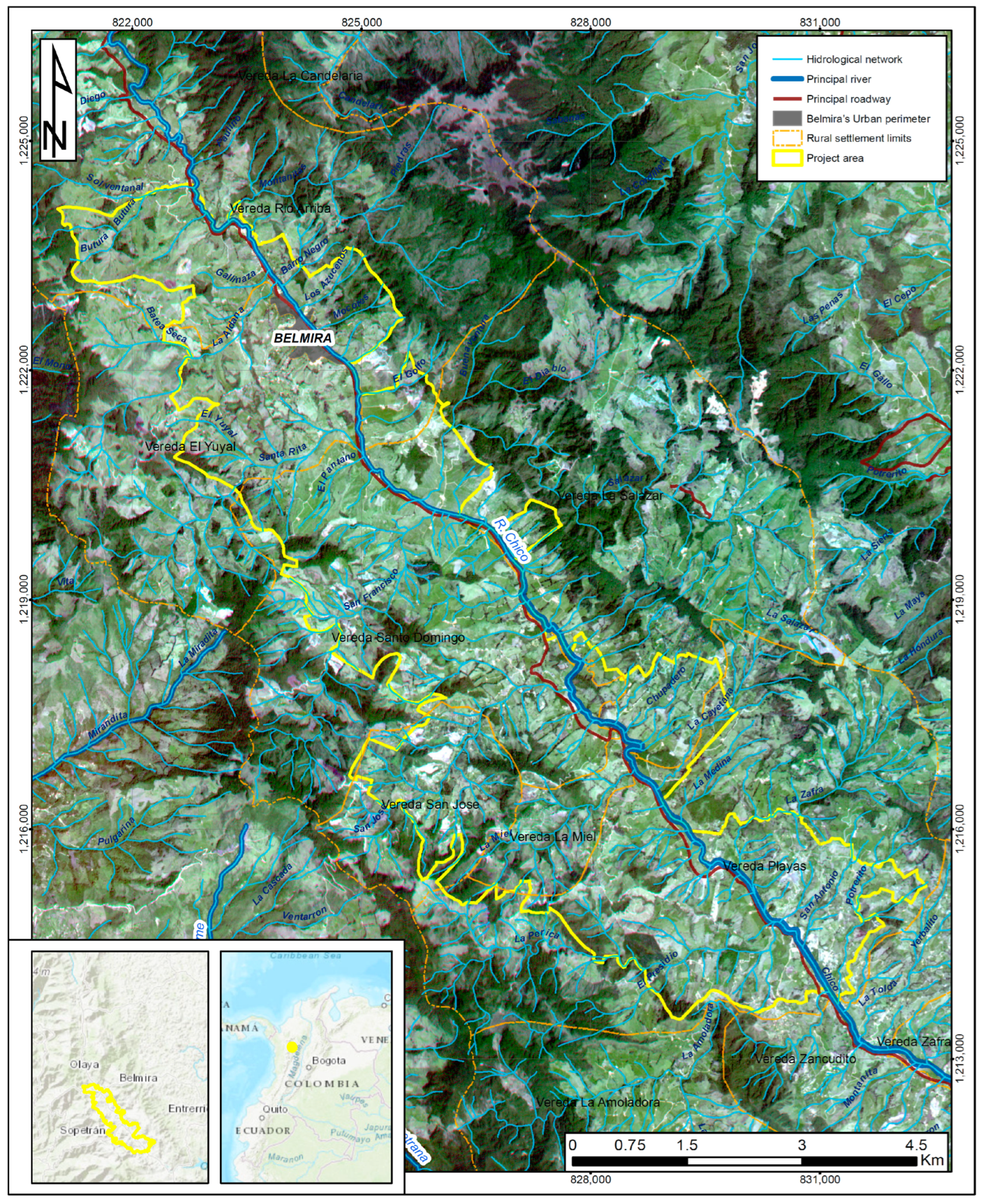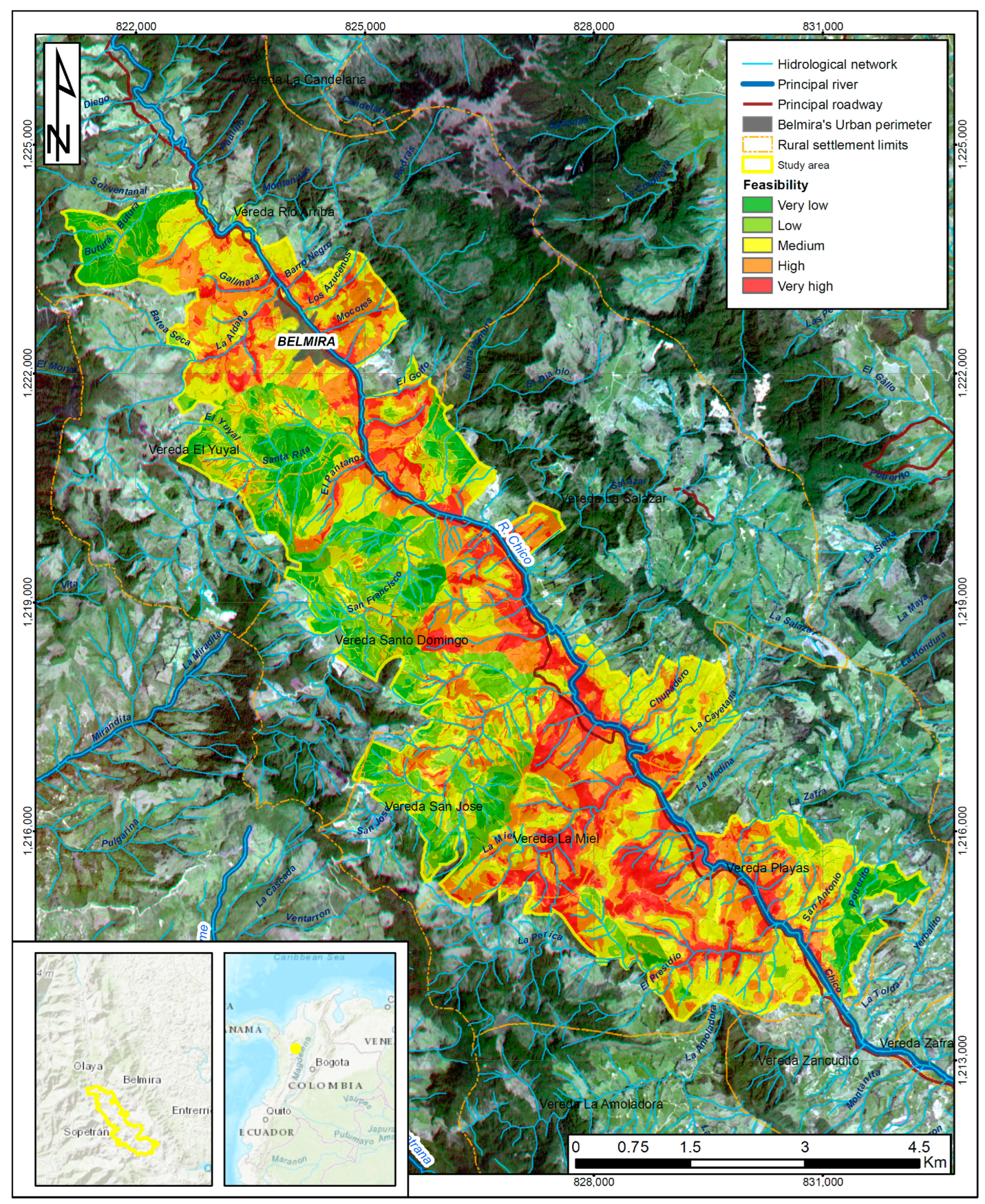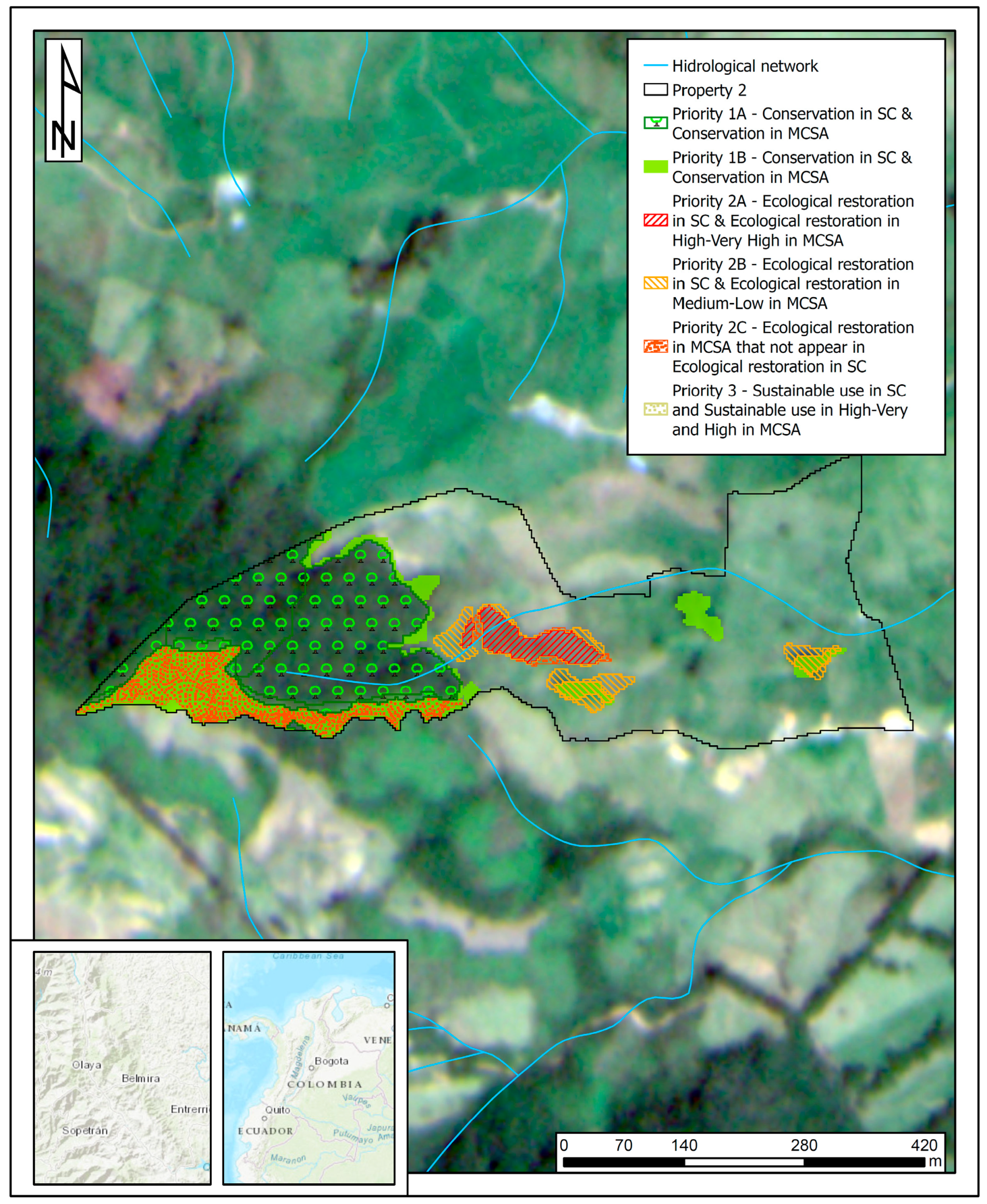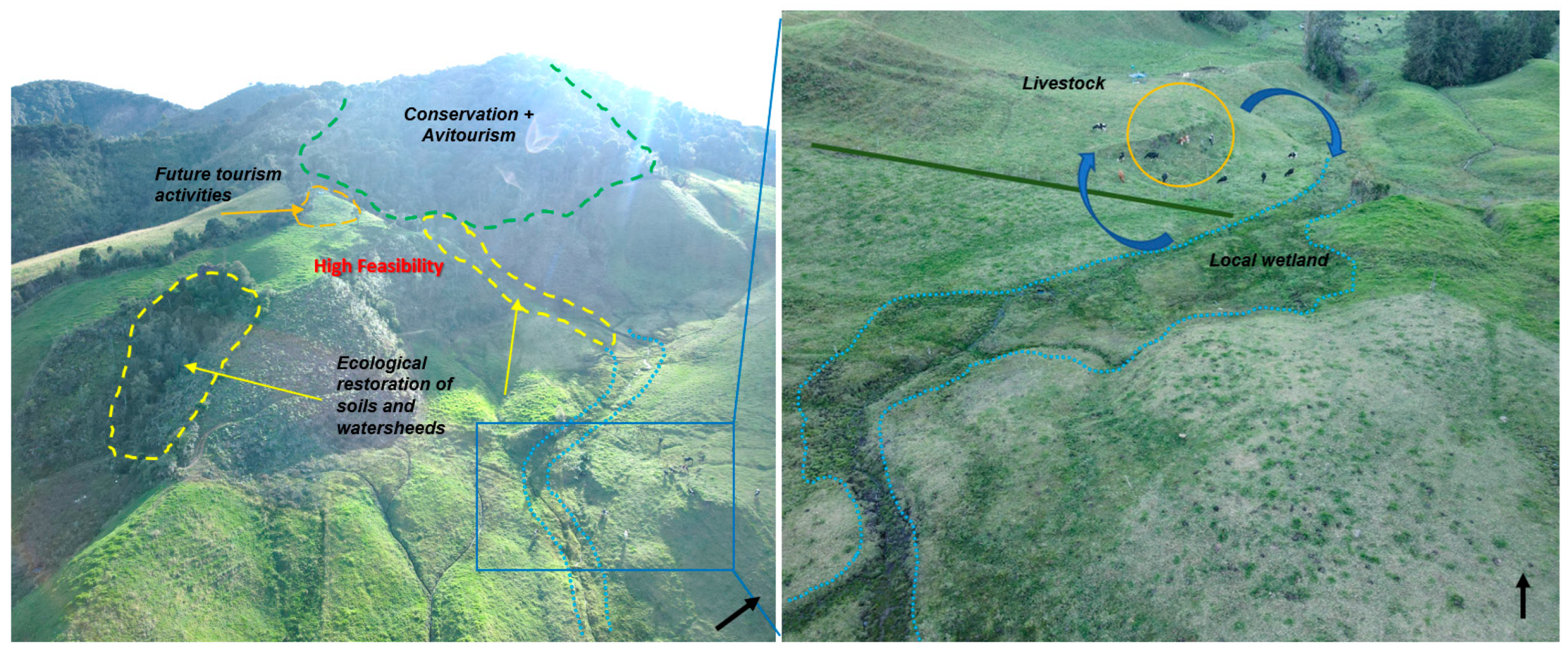Harmonization Approach to Spatial and Social Techniques to Define Landscape Restoration Areas in a Colombian Andes Complex Landscape
Abstract
:1. Introduction
2. Materials and Methods
2.1. Study Area
2.2. Restoration Goals in the Study Area
2.3. Identification of Landscape Restoration Areas and Activities
2.4. Localization of Areas and Landscape Restoration Activities
2.5. Harmonization of Techniques for Defining Areas for Landscape Restoration
3. Results
4. Discussion
5. Conclusions
Supplementary Materials
Author Contributions
Funding
Institutional Review Board Statement
Informed Consent Statement
Data Availability Statement
Acknowledgments
Conflicts of Interest
References
- Gann, G.D.; McDonald, T.; Walder, B.; Aronson, J.; Nelson, C.R.; Jonson, J.; Hallett, J.G.; Eisenberg, C.; Guariguata, M.R.; Liu, J.; et al. International principles and standards for the practice of ecological restoration. Restor. Ecol. 2019, 27, S1–S46. [Google Scholar] [CrossRef]
- Brancalion, P.H.S.; Niamir, A.; Broadbent, E.; Crouzeilles, R.; Barros, F.S.M.; Almeyda Zambrano, A.M.; Baccini, A.; Aronson, J.; Goetz, S.; Leighton Reid, J.; et al. Global restoration opportunities in tropical rainforest landscapes. Sci. Adv. 2019, 5, eaav3223. [Google Scholar] [CrossRef] [PubMed]
- Millennium Ecosystem Assessment. Guide to the Millennium Assessment Reports. 2005. Available online: https://www.millenniumassessment.org/en/index.html (accessed on 19 May 2022).
- United Nations Environment Programme. Becoming #GenerationRestoration. Ecosystem Restoration for People, Nature and Climate. 2021. Available online: https://wedocs.unep.org/bitstream/handle/20.500.11822/36251/ERPNC.pdf (accessed on 1 July 2022).
- Besseau, P.; Graham, S.; Christophersen, T. (Eds.) Restoring Forests and Landscapes: The Key to a Sustainable Future; Global Partnership on Forest and Landscape Restoration: Vienna, Austria, 2018. [Google Scholar]
- Rietbergen-McCracken, J.; Maginnis, S.; Alastair, S. (Eds.) The Forest Landscape Restoration Handbook; Taylor & Francis: New York, USA, 2007. [Google Scholar]
- Mansourian, S.; Vallauri, D.; Dudley, N. Forest Restoration in Landscapes. Beyond Planting Trees; Springer Science & Business Media: New York, NY, USA, 2005; p. 35. [Google Scholar]
- Mansourian, S.; Berrahmouni, N.; Blaser, J.; Dudley, N.; Maginnis, S.; Mumba, M.; Vallauri, D. Reflecting on twenty years of forest landscape restoration. Restor. Ecol. 2021, 29, 7. [Google Scholar] [CrossRef]
- Favretto, N.; Stringer, L.C.; Dougill, A.J.; Kruger, L. Knowledge exchange enhances engagement in ecological restoration and rehabilitation initiatives. Restor. Ecol. 2022, 30, e13565. [Google Scholar] [CrossRef]
- Swart, J.A.; Zevenberg, J.; Ho, P.; Cortina, J.; Reed, M.; Derak, M.; Vella, S.; Zhao, H.; van der Windt, H.J. Involving society in restoration and conservation. Restor. Ecol. 2018, 26, S3–S6. [Google Scholar] [CrossRef]
- Qu, Y.; Sun, G.; Luo, C.; Zeng, X.; Zhang, H.; Murray, N.; Xu, N. Identify ingrestoration priorities for wetlands based on historical distributions of biodiversity features and restoration suitability. J. Environ. Manag. 2019, 231, 1222–1231. [Google Scholar] [CrossRef]
- De Matos, T.P.V.; De Matos, V.P.V.; De Mello, K.; Valente, R.A. Protected areas and forest fragmentation: Sustainability index for prioritizing fragments for landscape restoration. Geol. Ecol. Landsc. 2021, 5, 19–31. [Google Scholar] [CrossRef]
- Terêncio, D.P.S.; Varandas, S.G.P.; Fonseca, A.R.; Cortes, R.M.V.; Fernandes, L.F.; Pacheco, F.A.L.; Monteiro, S.M.; Martinho, J.; Cabral, J.; Santos, J.; et al. Integrating ecosystem services into sustainable landscape management: A collaborative approach Science of the Total Environment Integrating ecosystem services into sustainable landscape management: A collaborative approach. Sci. Total Environ. 2021, 794, 148538. [Google Scholar] [CrossRef]
- Gonzalez, A.; Enríquez-de-Salamanca, Á. Spatial Multi-Criteria Analysis in Environmental Assessment: A Review and Reflection on Benefits and Limitations. J. Environ. Assess. Policy Manag. 2018, 20, 1840001. [Google Scholar] [CrossRef]
- Malczewski, J.; Jankowski, P. Emerging trends and research frontiers in spatial multicriteria analysis. Int. J. Geogr. Inf. Sci. 2020, 34, 1257–1282. [Google Scholar] [CrossRef]
- Kemppinen, K.M.S.; Collins, P.M.; Hole, D.G.; Wolf, C.; Ripple, W.J.; Gerber, L.R. Global reforestation and biodiversity conservation. Conserv. Biol. 2020, 34, 1221–1228. [Google Scholar] [CrossRef] [PubMed]
- Luther, D.; Beatty, C.R.; Cooper, J.; Cox, N.; Farinelli, S.; Foster, M.; Lamoreux, J.; Stephenson, P.J.; Brooks, T.M. Global assessment of critical forest and landscape restoration needs for threatened terrestrial vertebrate species. Glob. Ecol. Conserv. 2020, 24, e01359. [Google Scholar] [CrossRef]
- Mappin, B.; Chauvenet, A.L.M.; Adams, V.M.; Di Marco, M.; Beyer, H.L.; Venter, O.; Halpern, B.S.; Possingham, H.P.; Watson, J.E.M. Restoration priorities to achieve the global protected area target. Conserv. Lett. 2019, 12, 534. [Google Scholar] [CrossRef]
- Erbaugh, J.T.; Pradhan, N.; Adams, J.; Oldekop, J.A.; Agrawal, A.; Brockington, D.; Pritchard, R.; Chhatre, A. Global forest restoration and the importance of prioritizing local communities. Nat. Ecol. Evol. 2020, 4, 1472–1476. [Google Scholar] [CrossRef] [PubMed]
- Bastin, J.-F.; Finegold, Y.; Garcia, C.; Mollicone, D.; Rezende, M.; Routh, D.; Zohner, C.M.; Crowther, T.W. The global tree restoration potential. Science 2019, 365, 76–79. [Google Scholar] [CrossRef]
- Laestadius, L.; Maginnis, S.; Minnemeyer, S.; Potapov, P.; Saint-Laurent, C.; Sizer, N. Mapping opportunities for forest landscape restoration. Unasylva 2011, 62, 47–48. [Google Scholar]
- Strassburg, B.B.N.; Beyer, H.L.; Crouzeilles, R.; Iribarrem, A.; Barros, F.; de Siqueira, M.F.; Sánchez-Tapia, A.; Balmford, A.; Sansevero, J.B.B.; Brancalion, P.H.S.; et al. Strategic approaches to restoring ecosystems can triple conservation gains and halve costs. Nat. Ecol. Evol. 2019, 3, 62–70. [Google Scholar] [CrossRef]
- Van Der Esch, S.; Sewell, A.; Bakkenes, M.; Doelman, J.; Langhans, E.S.; Bouwman, A.; Brink, B.; Berkhout, E. The Global Potential for Land Restoration: Scenarios for the Global Land Outlook 2; Policy Report; PBL Netherlands Environmental Assessment Agency: The Hague, Netherlands, 2022; Available online: www.pbl.nl/en (accessed on 1 July 2022).
- Di Sacco, A.; Hardwick, K.A.; Blakesley, D.; Brancalion, P.H.S.; Breman, E.; Cecilio Rebola, L.; Chomba, S.; Dixon, K.; Elliott, S.; Ruyonga, G.; et al. Ten golden rules for reforestation to optimize carbon sequestration, biodiversity recovery and livelihood benefits. Glob. Chang. Biol. 2021, 27, 1328–1348. [Google Scholar] [CrossRef]
- César, R.G.; Belei, L.; Badari, C.G.; Viani, R.A.G.; Gutierrez, V.; Chazdon, R.L.; Brancalion, P.H.S.; Morsello, C. Forest and landscape restoration: A review emphasizing principles, concepts, and practices. Land 2021, 10, 28. [Google Scholar] [CrossRef]
- Edrisi, S.A.; Abhilash, P.C. Need of transdisciplinary research for accelerating land restoration during the UN Decade on Ecosystem Restoration. Restor. Ecol. 2021, 29, 8. [Google Scholar] [CrossRef]
- Bullock, J.M.; Fuentes-Montemayor, E.; McCarthy, B.; Park, K.; Hails, R.S.; Woodcock, B.A.; Watts, K.; Corstanje, R.; Harris, J. Future restoration should enhance ecological complexity and emergent properties at multiple scales. Ecography 2022, 4, 1–11. [Google Scholar] [CrossRef]
- Fagan, M.E.; Reid, J.L.; Holland, M.B.; Drew, J.G.; Zahawi, R.A. How feasible are global forest restoration commitments? Conserv. Lett. 2020, 13, e12700. [Google Scholar] [CrossRef]
- Johnson, C.J.; Drew, C.A.; Perera, A.H. Elicitation and Use of Expert Knowledge in Landscape Ecological Applications: A Synthesis. In Expert Knowledge and Its Application in Landscape Ecology; Springer: New York, NY, USA, 2012; pp. 279–299. [Google Scholar] [CrossRef]
- Orsi, F.; Geneletti, D.; Newton, A.C. Towards a common set of criteria and indicators to identify forest restoration priorities: An expert panel-based approach. Ecol. Indic. 2011, 11, 337–347. [Google Scholar] [CrossRef]
- Lim, V.C.; Justine, E.V.; Yusof, K.; Mohamad Ariffin, W.N.S.W.; Goh, H.C.; Fadzil, K.S. Eliciting local knowledge of ecosystem services using participatory mapping and Photovoice: A case study of Tun Mustapha Park, Malaysia. PLoS ONE 2021, 16, e0253740. [Google Scholar] [CrossRef]
- Duarte Hernández, D.; Avella Muñoz, E.A. Análisis socio-ecológico de una iniciativa de restauración liderada por autoridades ambientales en Santander, Colombia. Colomb. For. 2018, 22, 68–86. [Google Scholar] [CrossRef]
- Brancalion, P.H.S.; Holl, K.D. Guidance for successful tree planting initiatives. J. Appl. Ecol. 2020, 57, 2349–2361. [Google Scholar] [CrossRef]
- Holl, K.D.; Brancalion, P.H.S. Tree planting is not a simple solution. Science 2020, 368, 580–581. [Google Scholar] [CrossRef]
- Liebman, M.; Paulston, R.G. Social Cartography: A new methodology for comparative studies. Comp. A J. Comp. Int. Educ. 1994, 24, 233–245. [Google Scholar] [CrossRef]
- O’Hagan, A. Expert Knowledge Elicitation: Subjective but Scientific. Am. Stat. 2019, 73, 69–81. [Google Scholar] [CrossRef]
- IDEAM; Instituto Humbolt; INVEMAR; IGAC. Mapa de ecosistemas continentales, costeros y marinos de Colombia. Escala 1:100.000; Memoria técnica; IDEAM: Bogotá, Colombia, 2017. Available online: http://www.ideam.gov.co/web/ecosistemas (accessed on 6 June 2022).
- CORANTIOQUIA. Aunar esfuerzos para realizar los estudios de amenaza, vulnerabilidad y riesgo, en municipios de la región norte de Antioquia. Convenio interadministrativo de Asociación: Departamento de Antioquia-Departamento Administrativo de Planeación-Corantioquia; Reporte; CORANTIOQUIA: Medellín, Colombia, 2015. Available online: https://www.corantioquia.gov.co/ciadoc/flora/AIRNR_CV_1409_68_2014.pdf (accessed on 7 June 2022).
- Bolaños-Valencia, I.; Villegas-Palacio, C.; López-Gómez, C.P.; Berrouet, L.; Ruiz, A. Social perception of risk in socio-ecological systems. A qualitative and quantitative analysis. Ecosyst. Serv. 2019, 38, 65. [Google Scholar] [CrossRef]
- Laestadius, L.; Maginnis, S.; Rietbergen-Mccracken, J.; Saint-Laurent, C.; Shaw, D.; Verdone, M. Guía sobre la metodología de evaluación de oportunidades de restauración (ROAM). Evaluación de las Oportunidades de Restauración del Paisaje Forestal a Nivel Nacional o Subnacional; IUCN and WRI; IUCN: Gland, Suiza, 2014; Available online: https://portals.iucn.org/library/sites/library/files/documents/2014-030-Es.pdf (accessed on 24 March 2022).
- McLain, R.; Lawry, S.; Guariguata, M.R.; Reed, J. Integración de la tenencia y la gobernanza en las evaluaciones de oportunidades de restauración del paisaje forestal. CIFOR Infobrief. 2019, 244, 1–8. [Google Scholar] [CrossRef]
- Catastro Antioquia. Catastro en Línea. Información geográfica del municipio de Belmira, Antioquia. In Gobernación de Antioquia; 2021. Available online: https://www.catastroantioquia.co/ (accessed on 13 April 2022).
- Berrouet, L.; Villegas-Palacio, C.; Botero, V. Vulnerability of Rural Communities to Change in an Ecosystem Service Provision: Surface water supply. A Case Study in the Northern Andes, Colombia. Land Use Policy 2020, 97, 104737. [Google Scholar] [CrossRef]
- Suarez-Pardo, A.; Villegas-Palacio, C.; Berrouet, L. Resilience in Agroecosystems: An Index Based on a Socioecological Systems Approach. Wea. Climate Soc. 2022, 14, 425–438. [Google Scholar] [CrossRef]
- Tobón, C. Ecohydrology of Tropical Andean Cloud Forests. In The Andean Cloud Forest; Myster, R.W., Ed.; Springer Nature: Basel, Switzerland, 2021; pp. 61–87. [Google Scholar] [CrossRef]
- Vera Ramirez, P.Y. Trade Off Entre Servicios Ecosistémicos y sus Implicaciones en el Diseño de un Esquema de Pagos por Servicios Ambientales. Master’s Thesis, Universidad Nacional de Colombia—Sede Medellín, Medellín, Colombia, 2018. Available online: http://bdigital.unal.edu.co/71159/ (accessed on 27 September 2022).
- Correa, V.; Sanín, M.J.; Tuberquia, D. Transición bosque altoandino—páramo: Composición, estructura y fisonomía de la vegetación en la Cordillera Central de Colombia. Caldasia 2023, 45, 174–186. [Google Scholar] [CrossRef]
- Castaño Espinal, J.R. Evaluación de la Dinámica Asociada a los Principales Grupos de Interés y los Servicios Ecosistémicos Como Aporte a la Actualización del Plan de Manejo del Distrito de Manejo Integrado (DMI) del Sistema de Páramos y Bosques Altoandinos del Noroccidente Medellín. Master’s Thesis, Instituto Tecnológico Metropolitano—ITM, Medellín, Colombia, 2020. [Google Scholar]
- Gonzalez, M.; Jose, L. Zonas Prioritarias Para Restauración del Paisaje en Belmira, Antioquia, Colombia. Master’s Thesis, Instituto Tecnológico Metropolitano ITM, Medellín, Colombia, 2022. [Google Scholar]
- Camelo, O. Determinantes Ambientales y de Uso de la Tierra de la Recuperación de los Bosques en una Matriz de Paisaje Antrópico: Cuenca del Río Grande—Antioquia. Master’s Thesis, Universidad Nacional de Colombia—Sede Medellín, Medellín, Colombia, 2015. [Google Scholar]
- Diez-Gómez, M.C.D.; Sepúlveda, Y.L.; Moreno, F. Desarrollo inicial del roble andino en respuesta al manejo en vivero y durante la plantación. Colomb. For. 2017, 20, 118–130. [Google Scholar] [CrossRef]
- Camelo, O.; Urrego, L.E.; Orrego, S.A. Environmental and socioeconomic drivers of woody vegetation recovery in a human-modified landscape in the Rio Grande basin (Colombian Andes). Restor. Ecol. 2017, 25, 912–921. [Google Scholar] [CrossRef]
- Saaty, R. The analytic hierarchy process—What it is and How it is used. Math. Model. 1987, 9, 161–176. [Google Scholar] [CrossRef]
- Rahman, M.R.; Shi, Z.H.; Chongfa, C. Assessing regional environmental quality by integrated use of remote sensing, GIS, and spatial multi-criteria evaluation for prioritization of environmental restoration. Environ. Monit. Assess. 2014, 186, 6993–7009. [Google Scholar] [CrossRef]
- Aznar Bellver, J.; Guijarro Martínez, F. Nuevos Métodos de Valoración. Modelos Multicriterio; Universitat Politècnica de València: Valencia, España, 2012. [Google Scholar]
- Saaty, T.L. The Analytic Hierarchy Process; McGraw-Hill: New York, NY, USA, 1980. [Google Scholar]
- Isaacs-Cubides, P.J.; Aguilar Garavito, M.; Rojas, T.; Marín, W.; Correa Aya, C.A.; Díaz Timote, J.; Ramiréz, W.; Garay, J.; Rodríguez, C.; Rodríguez, J.; et al. Restauración del Paisaje en la Amazonia Colombiana. 2020. Available online: http://reporte.humboldt.org.co/biodiversidad/2019/cap4/402/#seccion10 (accessed on 20 January 2022).
- ESRI. Data Classification Methods: Natural Breaks (Jenks). 2021. Available online: https://pro.arcgis.com/en/pro-app/latest/help/mapping/layer-properties/data-classification-methods.htm (accessed on 8 November 2022).
- Noth, T.; Rinner, C. Prioritization in wildfire restoration using gis-based ordered weighted averaging (Owa): A case study in southern california. AIMS Environ. Sci. 2021, 8, 481–497. [Google Scholar] [CrossRef]
- Garthwaite, P.H.; Kadane, J.B.; Hagan, A.O. Statistical Methods for Eliciting Probability Distributions. J. Am. Stat. Assoc. 2005, 100, 680–701. [Google Scholar] [CrossRef]
- Correa-Morales, J.C.; Barrera-Causil, C. Elicitation of the parameters of multiple linear models. Rev. Colomb. Estad. 2021, 44, 159–170. [Google Scholar] [CrossRef]
- Alcaldía de Belmira Antioquia. Programa de Gobierno. In Periodo 2020–2023 Belmira, es Hora de Avanzar; Alcaldía de Belmira: Belmira, Colombia, 2020. [Google Scholar]
- Newton, A.C.; Tejedor, N. Principles and Practice of Forest Landscape Restoration: Case Studies from the Drylands of Latin America; IUCN: Gland, Switzerland, 2011; Available online: https://portals.iucn.org/library/node/9872 (accessed on 24 March 2022).
- Martínez-Flórez, G.; Elal-Olivero, D.; Barrera-Causil, C. Extended Generalized Sinh-Normal Distribution. Mathematics 2021, 9, 2793. [Google Scholar] [CrossRef]
- Robertson, H.T.; Allison, D.B. A novel generalized normal distribution for human longevity and other negatively skewed data. PLoS ONE 2012, 7, e37025. [Google Scholar] [CrossRef]
- Correa-Morales, J.C.; Barrera-Causil, C.J. Introducción a la Estadística Bayesiana; Fondo Editorial ITM: Medellín, Colombia, 2018; p. 222. [Google Scholar] [CrossRef]
- Hernández-Gómez, R.C.; Cantillo-Higuera, E. La restauración ecológica como estrategia de construcción social en la Vereda Chipautá, Municipio de Guaduas, Cundinamarca. Ambiente Desarro. 2019, 22, 1–15. [Google Scholar] [CrossRef]
- Gil Grandett, N.I.; Ayola Gómez, I.J. La cartografía participativa como herramienta para la acción política, dos estudios de caso en espacios rurales y urbanos en Colombia. Rev. Del Dep. De Geogr. FFyH–UNC–Argent. 2019, 12, 290–316. [Google Scholar]
- Borda-Niño, M.; Ceccon, E.; Meli, P.; Hernández-Muciño, D.; Mas, J.F.; Brancalion, P.H.S. Integrating farmers’ decisions on the assessment of forest regeneration drivers in a rural landscape of Southeastern Brazil. Perspect. Ecol. Conserv. 2021, 19, 338–344. [Google Scholar] [CrossRef]
- Delzeit, R.; Pongratz, J.; Schneider, J.M.; Schuenemann, F.; Mauser, W.; Zabel, F. Forest restoration: Expanding agriculture. Science 2019, 366, 315. [Google Scholar] [CrossRef] [PubMed]
- Von Holle, B.; Yelenik, S.; Gornish, E.S. Restoration at the landscape scale as a means of mitigation and adaptation to climate change. Curr. Landsc. Ecol. Rep. 2020, 5, 85–97. [Google Scholar] [CrossRef]
- Camargo Ponce de León, G.; Guerrero Ruiz, G.A. Lineamientos Técnicos Para la Declaratoria y Gestión de Zonas Amortiguadoras (Parques Nacionales Naturales de Colombia (Ed.)); Panamericana Formas e Impresos S.A.: Bogotá, Colombia, 2005. [Google Scholar]
- Salazar Moncada, P.A. Evaluación de los Servicios Ecosistémicos Culturales Asociados al Páramo de Santa Inés en el Municipio de Belmira—Antioquia. Master’s Thesis, Instituto Tecnológico Metropolitano ITM, Medellín, Colombia, 2019. [Google Scholar]
- Uribe, D.; Geneletti, D.; Del Castillo, R.F.; Orsi, F. Integrating stakeholder preferences and GIS. Based Multicriteria Analysis to Identify Forest Landscape Restoration Priorities. Sustainability 2014, 6, 935–951. [Google Scholar] [CrossRef]
- Niemiec, R.M.; Willer, R.; Ardoin, N.M.; Brewer, F.K. Motivating landowners to recruit neighbors for private land conservation. Conserv. Biol. 2019, 33, 930–941. [Google Scholar] [CrossRef] [PubMed]
- Aguirre-Salado, C.A.; Miranda-Aragón, L.; Pompa–García, M.; Reyes-Hernández, H.; Soubervielle-Montalvo, C.; Flores-Cano, J.A.; Méndez–Cortés, H. Improving identification of areas for ecological restoration for conservation by integrating USLE and MCDA in a gis-environment: A pilot study in a priority region northern Mexico. ISPRS Int. J. Geo-Inf. 2017, 6, 9. [Google Scholar] [CrossRef]







| ID Property Area | Area (ha) | Area (%) | Rural Settlements | ID Property Area | Area (ha) | Area (%) | Rural Settlements |
|---|---|---|---|---|---|---|---|
| 1 | 6.41 | 1.53% | San José | 8 | 3.70 | 0.88% | San José |
| 2 | 18.76 | 4.47% | Santo Domingo | 9 | 86.88 | 20.72% | Río Arriba |
| 3 | 53.74 | 12.81% | Santo Domingo | 10 | 3.33 | 0.79% | La Miel |
| 4 | 15.57 | 3.71% | El Yuyal | 11 | 2.55 | 0.61% | El Yuyal |
| 5 | 7.93 | 1.89% | Playas | 12 | 107.45 | 25.62% | Río Arriba |
| 6 | 3.33 | 0.79% | Playas | 13 | 82.73 | 19.73% | Río Arriba |
| 7 | 22.61 | 5.39% | San José | 14 | 4.40 | 1.05% | El Yuyal |
| 419.37 | 100.00% |
| Variable | Criterion | Weight (%) |
|---|---|---|
| V02—Erosion and landslides | Ecological (Enhancement of ecosystem services) | 22% |
| V04—Water importance | Ecological/Socioeconomic | 20% |
| V01—Land cover | Ecological/Socioeconomic | 17% |
| V05—Ecological connectivity | Ecological | 16% |
| V03—Flooding | Ecological (Enhancement of ecosystem services) | 8% |
| V09—Distance to forest loss | Ecological/Socioeconomic | 8% |
| V07—Properties with living fences | Socioeconomic (Territorial context) | 4% |
| V08—Density of constructions | Socioeconomic (Territorial context) | 3% |
| V06—Properties with conservation processes | Socioeconomic (Territorial context) | 2% |
| Activity | α | β | Mean | Median | SD | IQR | Min | Max |
|---|---|---|---|---|---|---|---|---|
| A1 | 2.64 | 0.17 | 0.945 | 0.997 | 0.112 | 0.0488 | 0.190 | 1 |
| A2 | 2.60 | 0.18 | 0.935 | 0.994 | 0.127 | 0.0625 | 0.088 | 1 |
| A3 | 3.07 | 0.08 | 0.974 | 1.000 | 0.080 | 0.0060 | 0.131 | 1 |
| A4 | 2.56 | 0.20 | 0.931 | 0.991 | 0.128 | 0.0716 | 0.205 | 1 |
| A5 | 2.56 | 0.20 | 0.923 | 0.989 | 0.138 | 0.0868 | 0.075 | 1 |
| Activities | ||
|---|---|---|
| Landscape Restoration | Evaluated through EKE | Other Proposals by Landowners in Social Mapping |
| Conservation | A4: Nature tourism * A5: Birdwatching * |
|
| Ecological Restoration | A3: Watershed and soil restoration |
|
| Sustainable Use | A1: Living fences A2: Crop rotation A4: Nature tourism A5: Birdwatching |
|
| Social Mapping | ||||||
|---|---|---|---|---|---|---|
| Activity | Conservation | Ecological Restoration | Sustainable Use | Infrastructure (No Activity) | Total (ha) | Total (%) |
| Conservation | 4.48 | 0.17 | 0.38 | 5.04 | 26.97% | |
| Ecological restoration | 1.43 | 0.49 | 0.08 | 2.01 | 10.75% | |
| Sustainable use | 0.12 | 0.46 | 10.68 | 0.23 | 11.48 | 61.50% |
| Infrastructure | 0.10 | 0.05 | 0.15 | 0.78% | ||
| Total (ha) | 6.13 | 1.13 | 11.19 | 0.23 | 18.67 | 100% |
| Total (%) | 32.83% | 6.02% | 59.92% | 1.22% | 100% | |
Disclaimer/Publisher’s Note: The statements, opinions and data contained in all publications are solely those of the individual author(s) and contributor(s) and not of MDPI and/or the editor(s). MDPI and/or the editor(s) disclaim responsibility for any injury to people or property resulting from any ideas, methods, instructions or products referred to in the content. |
© 2023 by the authors. Licensee MDPI, Basel, Switzerland. This article is an open access article distributed under the terms and conditions of the Creative Commons Attribution (CC BY) license (https://creativecommons.org/licenses/by/4.0/).
Share and Cite
Barrera-Causil, C.; González-Montañez, J. Harmonization Approach to Spatial and Social Techniques to Define Landscape Restoration Areas in a Colombian Andes Complex Landscape. Forests 2023, 14, 1913. https://doi.org/10.3390/f14091913
Barrera-Causil C, González-Montañez J. Harmonization Approach to Spatial and Social Techniques to Define Landscape Restoration Areas in a Colombian Andes Complex Landscape. Forests. 2023; 14(9):1913. https://doi.org/10.3390/f14091913
Chicago/Turabian StyleBarrera-Causil, Carlos, and Jose González-Montañez. 2023. "Harmonization Approach to Spatial and Social Techniques to Define Landscape Restoration Areas in a Colombian Andes Complex Landscape" Forests 14, no. 9: 1913. https://doi.org/10.3390/f14091913
APA StyleBarrera-Causil, C., & González-Montañez, J. (2023). Harmonization Approach to Spatial and Social Techniques to Define Landscape Restoration Areas in a Colombian Andes Complex Landscape. Forests, 14(9), 1913. https://doi.org/10.3390/f14091913






